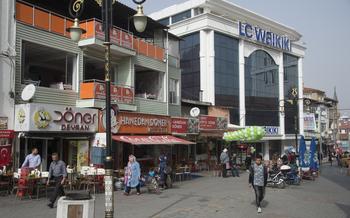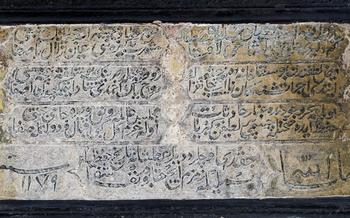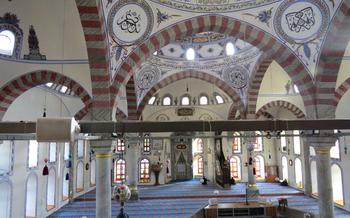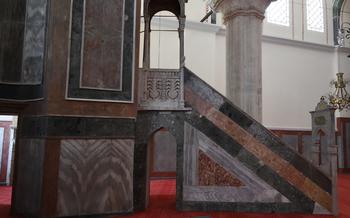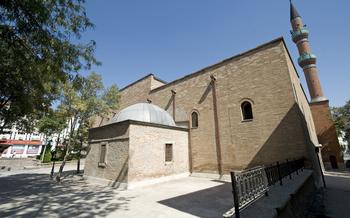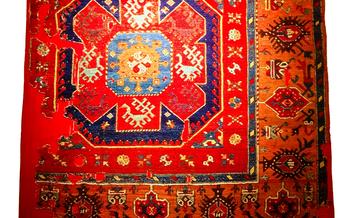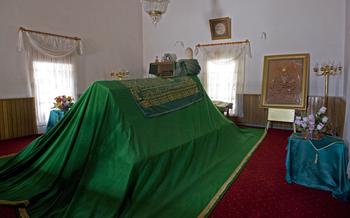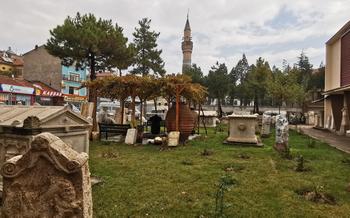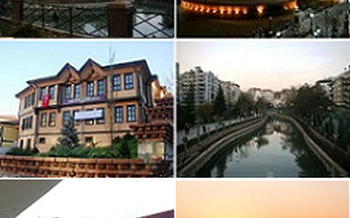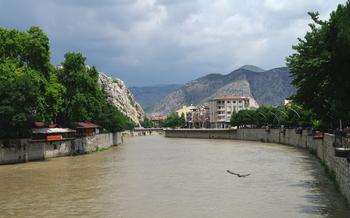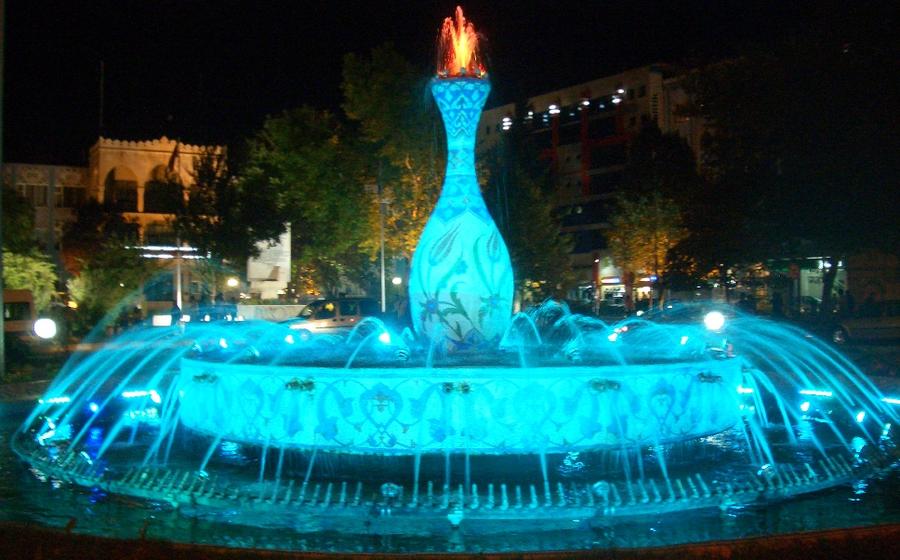
Tabduk Emre Tomb
- The Tabduk Emre Tomb: A Historical Gem
- Unveiling the Life of Tabduk Emre
- Exploring the Tomb Complex
- Delving into Tabduk Emre's Poetry
- Witnessing the Dervish Rituals
- Uncovering the Legends and Myths
- Seeking Spiritual Guidance
- Exploring the Surrounding Area
- Indulging in Local Delights
- Discovering Local Handicrafts
- Participating in Cultural Events
- Interacting with the Locals
- Capturing the Beauty
- Finding Accommodation
- Insider Tip: Unveiling the Hidden Gem
The Tabduk Emre Tomb: A Historical Gem
Nestled in the heart of Kütahya, Turkey, lies the awe-inspiring Tabduk Emre Tomb, a testament to the region's rich history and cultural heritage. Built in the 14th century, the tomb has stood as a beacon of spirituality and a symbol of the enduring legacy of Tabduk Emre, a revered Sufi poet and mystic who left an indelible mark on Turkish literature and mysticism.
The tomb's architectural grandeur reflects the artistry and craftsmanship of its time. Its intricate carvings, delicate tilework, and graceful minarets blend harmoniously, creating a sense of awe and serenity. Inside, the tomb houses the resting place of Tabduk Emre, a figure deeply revered by the local community and pilgrims alike.
Beyond its architectural beauty, the Tabduk Emre Tomb holds immense cultural significance. It serves as a pilgrimage site for those seeking spiritual guidance and inspiration, and its annual festivals and ceremonies attract visitors from far and wide. The tomb stands as a symbol of unity and tolerance, embodying the harmonious coexistence of different faiths and beliefs that have shaped Kütahya's rich tapestry of cultural heritage.
Unveiling the Life of Tabduk Emre
Tabduk Emre, a revered Sufi poet and mystic, left an indelible mark on Turkish literature and spirituality. Born in the 13th century in the Anatolian region of Turkey, he was a prolific writer and a charismatic teacher who inspired generations with his teachings on love, humility, and compassion. His profound insights into the human soul and the nature of existence continue to resonate with readers and seekers of truth to this day.
Emre's poetry, written in a simple yet evocative style, delved into themes of divine love, the transient nature of life, and the search for inner peace. His verses, often infused with symbolism and allegory, explored the complexities of the human condition and offered guidance on the path to spiritual enlightenment. Emre's teachings emphasized the importance of cultivating a pure heart, free from worldly desires and attachments, and of seeking unity with the divine.
As a spiritual guide, Emre attracted a large following of disciples who sought his wisdom and guidance. He established a tekke, or Sufi lodge, where he taught and nurtured his students, guiding them on their spiritual journeys. Emre's teachings transcended religious boundaries, and people from all walks of life were drawn to his message of love and compassion. His legacy continues to inspire and guide seekers of truth to this day, making him one of the most influential figures in Turkish literature and spirituality.
Exploring the Tomb Complex
At the heart of the Tabduk Emre Tomb complex lies the mausoleum of the revered Sufi poet and mystic. Constructed in the 14th century, this sacred structure exudes an aura of serenity and spirituality, inviting visitors to immerse themselves in the tranquil atmosphere. The mausoleum features intricate tilework and ornate carvings that showcase the craftsmanship of the era. Inside, visitors can pay their respects at the tomb of Tabduk Emre, where they can offer prayers and seek blessings.
Surrounding the mausoleum are several other structures that add to the significance of the complex. These include a mosque, a madrasah (Islamic school), and a tekke (dervish lodge). The mosque, with its graceful minaret, serves as a place of worship for the local community and pilgrims alike. The madrasah, once a center of Islamic learning, now stands as a testament to Tabduk Emre's commitment to education and knowledge. The tekke, where dervishes once gathered for spiritual practices and rituals, offers a glimpse into the mystical traditions of Sufism.
Together, these structures form a harmonious ensemble that reflects the multifaceted legacy of Tabduk Emre. Visitors can wander through the complex, exploring each building and soaking in the serene atmosphere. The grounds are meticulously maintained, with lush gardens and tranquil courtyards that invite visitors to linger and reflect on the teachings and wisdom of this revered figure.
Delving into Tabduk Emre's Poetry
Tabduk Emre's poetry is a treasure trove of profound themes and motifs that explore the essence of human existence, the beauty of nature, and the connection to the divine. His verses often revolve around the concepts of love, humility, and compassion, reflecting his Sufi beliefs and teachings.
The literary style of Tabduk Emre's poetry is characterized by its simplicity, directness, and use of everyday language. He employed various techniques such as metaphors, similes, and personification to create vivid imagery and convey deep meanings in a relatable manner.
Tabduk Emre's poetry has had a significant influence on Turkish literature, inspiring generations of poets and writers. His works are widely read and studied, and his teachings continue to resonate with readers who seek spiritual guidance and enlightenment.
Fortunately, translations of Tabduk Emre's poetry are available in various languages, allowing readers worldwide to appreciate his literary genius. These translations have played a crucial role in disseminating his teachings and fostering a wider understanding of his contributions to Turkish literature.
Witnessing the Dervish Rituals
The Tabduk Emre Tomb complex is not only a place of historical and spiritual significance but also a venue for witnessing the mesmerizing Sema ceremony, performed by the whirling dervishes. This sacred ritual is a mesmerizing sight that has captivated visitors for centuries.
The Sema ceremony is a form of Sufi dance that embodies the spiritual journey of the dervish towards enlightenment and union with the divine. During the ceremony, the dervishes, clad in flowing white robes, gracefully spin and twirl, symbolizing their surrender to God.
The movements of the dervishes are accompanied by the rhythmic sound of drums, flutes, and chanting, creating a mystical atmosphere within the tomb complex. The ceremony is a testament to the enduring legacy of Tabduk Emre's teachings and the profound spiritual significance of the site.
To witness the Sema ceremony, visitors are advised to check the schedule in advance, as it is usually held on specific days and times. Visitors should also be respectful of the sacred nature of the ceremony and observe silence during the performance.
Uncovering the Legends and Myths
The Tabduk Emre Tomb is not just a historical and spiritual site; it is also a place where legends and myths intertwine. Locals share stories and anecdotes about Tabduk Emre that have been passed down through generations, creating a rich tapestry of folklore and tradition.
One popular legend tells of Tabduk Emre's miraculous birth. It is said that his mother, Fatima, was a pious woman who longed for a child. One night, she had a dream in which a luminous figure appeared, promising her a son who would become a great saint. Fatima gave birth to Tabduk Emre shortly after.
Another story recounts an encounter between Tabduk Emre and a group of bandits. As the bandits approached, Tabduk Emre raised his hands in prayer, and a blinding light emanated from his body. The bandits were so astonished that they fell to their knees and repented their evil ways.
The tomb complex is also believed to possess supernatural powers. Visitors often leave offerings and prayers at Tabduk Emre's grave, seeking his blessings and intercession. Some claim to have experienced miraculous healings or received guidance and comfort during difficult times.
These legends and myths add to the mystique and allure of the Tabduk Emre Tomb. They remind us of the power of faith, the interconnectedness of all beings, and the enduring legacy of Tabduk Emre's teachings.
Seeking Spiritual Guidance
Tabduk Emre's tomb is not just a historical site but also a place of spiritual significance, where visitors can seek guidance and inspiration from his teachings. Emre was a renowned Sufi poet and mystic who espoused the values of love, humility, and compassion. His teachings resonated deeply with his followers, and his tomb has become a place of pilgrimage for those seeking spiritual enlightenment.
Visitors to the tomb can immerse themselves in Emre's teachings through the various texts and inscriptions displayed within the complex. These writings offer insights into his philosophy of life, his understanding of the divine, and his path to spiritual awakening. By delving into his words, visitors can gain a deeper understanding of themselves and their place in the universe.
The serene and tranquil atmosphere of the tomb complex further enhances the spiritual experience. The simplicity of the architecture, the soft light filtering through the windows, and the gentle sound of birdsong create a conducive environment for contemplation and reflection. Visitors can sit in silence, meditate, or simply bask in the peaceful ambiance, allowing Emre's teachings to permeate their souls.
For those seeking a more personal connection with Emre, there are opportunities to engage with local spiritual guides who can provide insights into his life and teachings. These guides can lead visitors through guided meditations, share stories and anecdotes about Emre, and offer advice on how to incorporate his principles into their daily lives.
Whether you are a seasoned spiritual seeker or simply curious about the teachings of Tabduk Emre, a visit to his tomb is a transformative experience that can provide solace, guidance, and a renewed sense of purpose.
Exploring the Surrounding Area
While the Tabduk Emre Tomb stands as the primary attraction, the surrounding area offers a wealth of additional experiences for visitors. History buffs can delve into the past at the Kütahya Castle, a magnificent fortress that has witnessed centuries of battles and conquests. Nature enthusiasts will find solace in the idyllic landscapes of the nearby Köprübaşı Waterfall, where cascading waters create a mesmerizing symphony. For those seeking a spiritual connection, the Ulu Mosque, with its intricate architecture and serene atmosphere, beckons for contemplation.
Beyond these landmarks, the region boasts an array of natural wonders that invite exploration. Visitors can embark on scenic hikes through the verdant forests, where towering trees provide a canopy of shade and the air is perfumed with the fragrance of wildflowers. The region's rivers and lakes offer opportunities for swimming, fishing, and boating, while hot springs promise a relaxing and rejuvenating experience.
For those with time to spare, day trips to nearby cities and towns offer a glimpse into the region's diverse cultural heritage. The bustling city of Eskişehir, with its vibrant student population, offers a lively atmosphere and a multitude of attractions, including museums, art galleries, and historic sites. The town of Seyitgazi, known for its thermal springs and healing waters, provides a tranquil retreat for those seeking relaxation and rejuvenation.
Transportation options in the area are varied and convenient. Public buses and minibuses connect the Tabduk Emre Tomb with nearby towns and cities, providing an affordable and reliable mode of travel. Rental cars offer the freedom and flexibility to explore the region at one's own pace, while guided tours provide a hassle-free way to discover the area's highlights.
Indulging in Local Delights
The Tabduk Emre Tomb is not just a historical and spiritual site; it's also an excellent place to experience the culinary delights of the region. The surrounding area is home to several restaurants and cafes that serve traditional Turkish cuisine, including regional specialties and dishes unique to Kütahya.
Don't miss the opportunity to savor the flavors of mouthwatering kebabs, succulent börek, or the regional specialty, "tabduk çorbası," a hearty soup named after the revered mystic. For a sweet treat, indulge in künefe, a crispy pastry filled with sweet cheese and drenched in syrup.
To fully immerse yourself in the local culinary experience, visit the weekly market in the town center. Here, you can find fresh produce, homemade jams, honey, and a variety of spices. You can also pick up some traditional Turkish coffee or tea to enjoy at the tomb complex or as a souvenir.
Whether you're a foodie looking to explore the local cuisine or simply want to enjoy a delicious meal after your visit to the Tabduk Emre Tomb, you're sure to find something to satisfy your taste buds in this vibrant and welcoming region.
Discovering Local Handicrafts
The Tabduk Emre Tomb complex is not only a spiritual and historical site but also a hub for traditional Turkish arts and crafts. The surrounding area is renowned for its skilled artisans who create exquisite handmade souvenirs and gifts. Visitors can explore the vibrant markets and bazaars, where they can find a wide array of unique items.
From intricate carpets and kilims to delicate pottery and jewelry, the local artisans showcase their mastery in various mediums. Each piece is a testament to the rich cultural heritage of the region. Whether you seek a meaningful souvenir to cherish or a special gift for loved ones back home, the markets offer a treasure trove of options.
Don't miss the opportunity to witness the artisans at work, demonstrating their skills and techniques. Their passion and dedication are evident in every creation. By supporting local artisans, you not only acquire beautiful handmade items but also contribute to preserving and promoting traditional Turkish craftsmanship.
Recommended Handicrafts to Look For:
-
Kilim Rugs: Handwoven flat-weave rugs, featuring vibrant geometric patterns and motifs.
-
Ceramics: Exquisite pottery items, including decorative plates, vases, and tiles, often adorned with intricate designs.
-
Jewelry: Handmade silver and gold jewelry, featuring traditional Turkish motifs and semi-precious stones.
-
Leatherwork: Handcrafted leather bags, shoes, and accessories, showcasing intricate embossing and tooling techniques.
-
Textiles: Colorful embroidered textiles, such as scarves, tablecloths, and pillow covers, featuring traditional Anatolian patterns.
Participating in Cultural Events
Tabduk Emre's tomb is not just a historical and spiritual site; it's also a vibrant cultural hub. Throughout the year, the tomb complex hosts a variety of events that celebrate Turkish culture and traditions. These events offer a unique opportunity for visitors to immerse themselves in the local way of life and gain a deeper understanding of Turkish heritage.
One of the most popular events is the annual Tabduk Emre Festival, held in July. This three-day festival features traditional music and dance performances, poetry readings, Sufi whirling dervish ceremonies, and a colorful bazaar selling local handicrafts and delicacies. It's a joyous celebration that attracts thousands of visitors from all over Turkey and beyond.
In addition to the Tabduk Emre Festival, the tomb complex also hosts regular cultural performances and exhibitions. These events showcase the talents of local artists and artisans, and provide a platform for them to share their work with the community. From traditional music concerts to art exhibitions and craft demonstrations, there's always something new and exciting happening at the tomb.
To fully experience the cultural richness of Tabduk Emre's tomb, be sure to check the event calendar before your visit. Whether you're interested in music, dance, poetry, or art, you're sure to find something that appeals to your interests. By participating in these events, you'll not only learn more about Turkish culture, but you'll also make lasting memories that will stay with you long after your visit.
Interacting with the Locals
The people of Kütahya are renowned for their warmth and hospitality, extending a welcoming embrace to visitors from all corners of the globe. While language barriers may pose a slight challenge, a smile, a nod, and a few basic Turkish phrases can go a long way in bridging the gap. Locals take pride in sharing their culture and traditions with visitors, offering a glimpse into the vibrant tapestry of Turkish life. Embrace the opportunity to engage in conversations, learn about their customs and perspectives, and forge genuine connections. Remember to be respectful of local customs and etiquette, such as removing your shoes when entering someone's home and refraining from pointing your feet at people or objects. Building friendships with the locals will not only enhance your travel experience but also leave you with lasting memories of the human connections you've made.
Capturing the Beauty
The Tabduk Emre Tomb and its surroundings offer a wealth of photographic opportunities. Capture the intricate details of the mausoleum's architecture, the serene beauty of the gardens, and the vibrant colors of the surrounding landscape. Whether you're a professional photographer or simply looking to document your travels, there's no shortage of Instagrammable spots at this historical gem.
For the best shots, visit the tomb during the golden hour, just before sunset, when the warm light casts a magical glow on the buildings and grounds. Don't forget to venture beyond the main complex to capture the surrounding countryside, dotted with traditional Turkish villages and lush greenery.
To truly capture the essence and atmosphere of the Tabduk Emre Tomb, take your time and explore the grounds at a leisurely pace. Find a quiet corner to sit and soak in the tranquility, allowing yourself to connect with the spiritual energy of the place. It's in these moments of stillness that you'll capture the most authentic and evocative images.
Once you've captured your memories, share them with the world on social media using relevant hashtags like #TabdukEmreTomb, #Kütahya, and #Turkey. Inspire others to embark on their own journey of discovery and to appreciate the rich cultural heritage of this hidden gem.
Finding Accommodation
When planning your trip to the Tabduk Emre Tomb, finding suitable accommodation is essential. Several options are available to cater to your needs and preferences.
Nearby Hotels and Guesthouses:
- Comfort and Convenience: For a comfortable and hassle-free stay, choose from nearby hotels or guesthouses.
- Range of Options: These establishments offer a variety of room types and amenities to suit different budgets and requirements.
- Proximity to the Tomb: Select a hotel or guesthouse within walking distance or a short drive from the tomb for easy access.
Homestays and Local Hospitality:
- Immersive Experience: Immerse yourself in the local culture by opting for a homestay with a welcoming Turkish family.
- Authentic Interactions: Connect with the locals, learn about their daily lives, and gain insights into their customs and traditions.
- Budget-Friendly Option: Homestays often provide a more affordable accommodation option compared to hotels.
Booking in Advance or Last-Minute Options:
- Peak Season Considerations: If visiting during the peak tourist season, book your accommodation in advance to secure your preferred choice.
- Flexibility and Spontaneity: For a more spontaneous trip, keep an open mind and explore last-minute accommodation options.
- Online Platforms and Local Recommendations: Utilize online booking platforms or seek recommendations from locals for the best deals and availability.
Balancing Budget and Comfort:
- Prioritize Needs: Determine your essential requirements and allocate your budget accordingly.
- Consider Amenities: Evaluate the amenities and facilities offered by different accommodations to ensure they meet your needs.
- Explore Value for Money: Compare prices and services to find the best value for your money.
Remember, the accommodation you choose will significantly impact your overall experience in Kütahya. Whether you prefer the convenience of a hotel, the authenticity of a homestay, or the flexibility of last-minute options, plan ahead to ensure a comfortable and enjoyable stay.
Insider Tip: Unveiling the Hidden Gem
Amidst the bustling streets of Kütahya, a hidden gem awaits discovery: the Ulu Mosque. This architectural masterpiece, nestled in the heart of the city, stands as a testament to the rich history and cultural heritage of Turkey. While the Tabduk Emre Tomb is a renowned attraction, the Ulu Mosque offers an equally captivating experience for those seeking spiritual enlightenment and historical exploration.
Dating back to the 14th century, the Ulu Mosque is a marvel of Islamic architecture. Its intricate carvings, majestic dome, and serene courtyard transport visitors to a bygone era. Step inside, and you'll be greeted by an awe-inspiring sanctuary adorned with colorful tiles, elegant calligraphy, and intricate mosaics.
Beyond its architectural beauty, the Ulu Mosque holds deep spiritual significance. It serves as a place of worship for the local Muslim community and welcomes visitors of all faiths. Join the faithful during prayer time to witness the mosque's vibrant atmosphere and immerse yourself in the tranquility of this sacred space.
To fully appreciate the Ulu Mosque, consider hiring a local guide who can share insights into its history, architecture, and cultural significance. They will lead you through the mosque's hidden corners, revealing stories and legends that bring its past to life.
Whether you're a history buff, a spiritual seeker, or simply someone who appreciates architectural wonders, the Ulu Mosque is a must-visit destination. Its unique charm and serene atmosphere will leave an unforgettable impression, making your journey to Kütahya truly complete.
